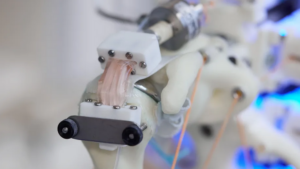The science of tissue engineering — or growing human cells for use in medicine — is very much in its infancy, with only the simplest lab-grown cells able to be used in experimental treatments today. But researchers say a new method of tissue engineering could potentially improve the quality of this work: growing the cells on a moving robot skeleton.
Typically, cells used in this sort of regenerative medicine are grown in static environments. Think: petri dishes and miniature 3D scaffolds. A few experiments in the past have shown that cells can be grown on moving structures like hinges, but these have only stretched or bent the tissue in a single direction. But researchers from the University of Oxford and robotics firm Devanthro thought that, if you want to grow matter designed to move and flex like tendons or muscles, it’d be better to recreate their natural growing environment as accurately as possible. So they decided to approximate a mobile human body.
Russia shot down Ukrainian military transport plane with foreign weapons
Growing cells in an actual person creates all sorts of difficulties, of course, so the cross-disciplinary team decided to approximate the human musculoskeletal system as best they could using a robot. As described in a paper published in Communications Engineering, they adapted an open-source robot skeleton designed by the engineers at Devanthro and created a custom growing environment for the cells that can be fitted into the skeleton to bend and flex as required. (Such growing environments are known as bioreactors.)
Read more: The Verge
Ask me anything
Explore related questions





